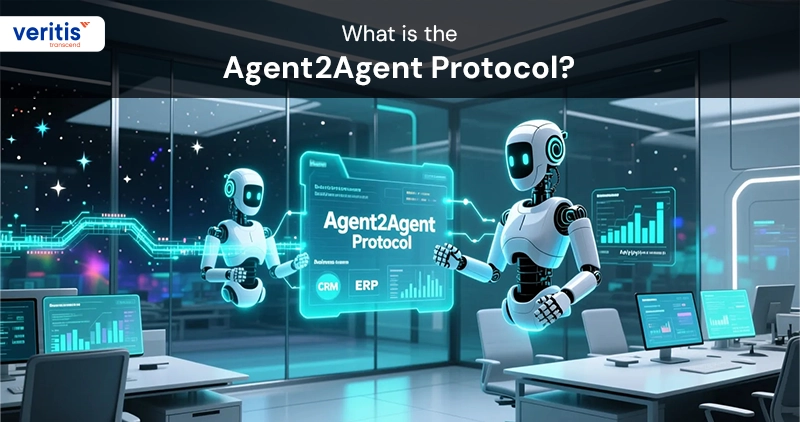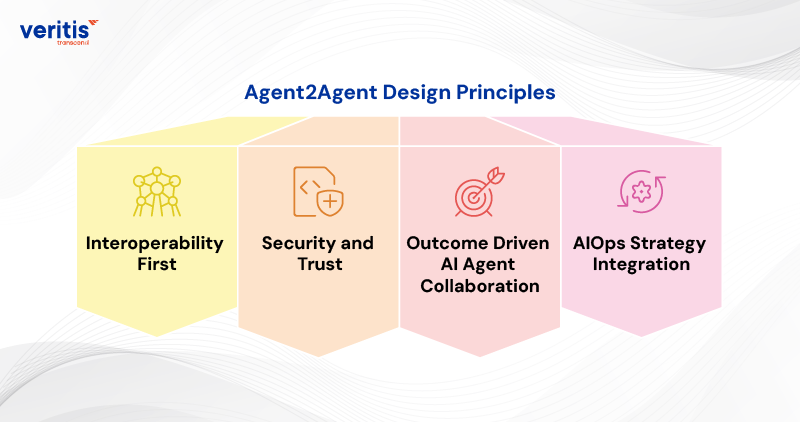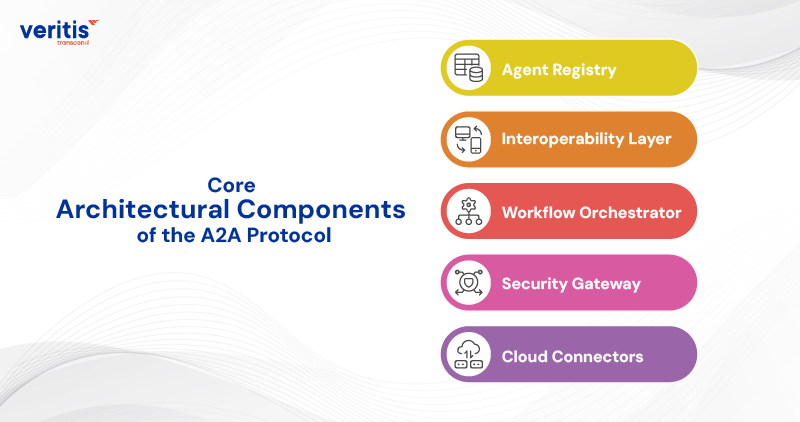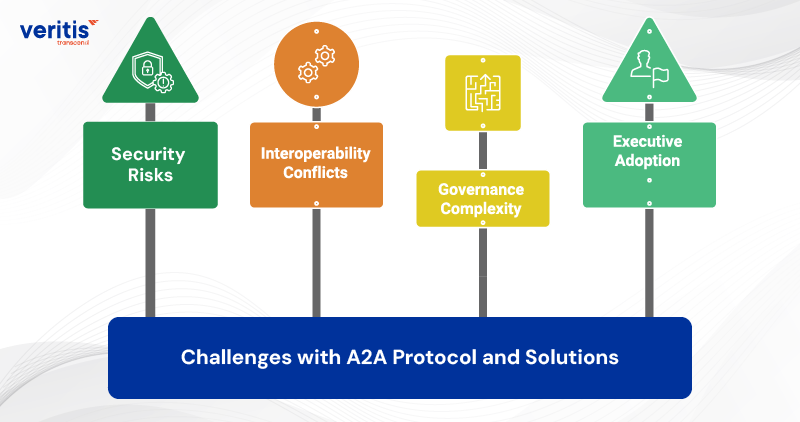
The next wave of enterprise growth will not come from adding more disconnected AI tools. It will come from intelligent agents that work together, securely, seamlessly, and at scale.
This is the potential of the Agent2Agent Protocol (A2A Protocol), a standard for AI agent collaboration, AI agent interoperability, and enterprise grade agent orchestration. It moves us beyond siloed automation to a model where agent to agent communication protocols enable AI agents to negotiate, execute, and deliver outcomes without human bottlenecks.
- CEOs and COOs experience the Agent2Agent Protocol transforming scattered AI pilots into enterprise wide intelligent ecosystems that drive agility and resilience across global operations.
- CIOs and CTOs benefit from multi agent orchestration that goes beyond A2A protocol vs MCP, ensuring seamless AI agent interoperability across vendors’ platforms and multi cloud environments.
- CFOs achieve measurable structural efficiency with up to 60 percent less downtime, 40 percent faster cycles, and 30 percent lower IT operations costs, directly improving EBITDA and shareholder value. This is where A2A AI proves its impact on financial performance.
- CISOs and Boards rely on secure AI agent integration, auditable workflows, and zero trust governance to ensure compliance, strengthen trust, and protect enterprise reputation at market scale.
At Veritis, we experience this as a defining inflection point. The enterprises that adopt A2A Protocols now will set the pace for their industries. Those who hesitate will remain stuck with fragmented systems, unable to capture the full value of multi agent workflow automation.
Request an AI Workflow Assessment
What is the Agent2Agent Protocol?
The Agent2Agent Protocol (A2A Protocol) is the emerging agent to agent communication protocol that enables independent AI systems to collaborate, share context, and complete tasks without human handoffs. Unlike conventional APIs, the A2A Protocol ensures AI agent interoperability and AI agent collaboration across departments, vendors, and multi cloud environments.
Consider it as the foundation for agent to agent communication AI, where finance bots reconcile accounts with procurement bots, or HR digital assistants coordinate seamlessly with IT operations bots. This is the new frontier of multi-agent systems enterprise.
By setting agent interoperability standards and establishing enterprise AI agent protocols, the Agent2Agent approach allows organizations to align operations across every function while maintaining security, compliance, and board level accountability.
How Does the A2A Protocol Work?
1) Negotiated Conversations Between Agents
The Agent2Agent Protocol (A2A Protocol) treats every agent as a peer, enabling AI agent collaboration through a shared agent to agent communication protocol for enterprises. For instance, a supply chain agent may request real time updates from a logistics agent, who in turn queries a pricing agent, all while maintaining context. This illustrates how AI agent interoperability eliminates silos and accelerates decision making.
2) Secure AI Agent Integration
Executives demand security at scale. The A2A Protocol enforces secure AI agent integration through encryption, identity management, and verification layers. This ensures that only authorized A2A AI agents can participate, preventing rogue actors from entering enterprise networks and protecting sensitive workflows.
3) Enterprise Grade Agent Orchestration
Every modern corporation requires enterprise-grade agent orchestration. With the A2A Protocol, enterprises align multiple agents into multi-agent workflow automation pipelines, ensuring collaboration is executed in predictable, auditable, and board compliant ways. This is where A2A and MCP diverge: while MCP optimizes context for a single model, the A2A Protocol vs MCP discussion highlights how A2A creates scalable, interoperable ecosystems that transform enterprise operations.
Useful Link: What is Cognitive Robotic Process Automation and How Does It Enhance Intelligent Automation?
Agent2Agent Design Principles

1) Interoperability First
The Agent2Agent Protocol (A2A Protocol) is built around AI agent interoperability and global agent interoperability standards. Enterprises cannot afford bespoke, siloed automation; they need a unified agent to agent communication protocol that connects finance, HR, supply chain, and IT systems seamlessly.
2) Security and Trust
The future of AI runs on trust. Secure AI agent integration ensures that only authenticated, authorized, and compliant agents participate in sensitive workflows. With A2A AI, enterprises gain the confidence to scale innovation without compromising governance.
3) Outcome Driven AI Agent Collaboration
Every exchange under the A2A Protocol must produce measurable outcomes. AI agent collaboration is not about experimentation but about systems tied directly to ROI, compliance, and enterprise growth. This is where A2A protocol vs MCP becomes clear: MCP optimizes single model efficiency, while A2A ensures enterprise broad collaboration and transformation.
4) AIOps Strategy Integration
The Agent2Agent Protocol does not stand alone. It exists within an AIOps strategy, where AIOps solutions connect into the broader IT backbone. In this context, A2A and MCP are complementary; MCP manages context at the model level, while A2A orchestrates intelligent collaboration across the enterprise.
Core Architectural Components of the A2A Protocol

1) Agent Registry
A catalog of enterprise AI agents that ensures every participant in agent to agent communication protocol frameworks is identified, authenticated, and trusted. This forms the backbone of Agent2Agent Protocol (A2A Protocol) governance.
2) Interoperability Layer
The layer where AI agent interoperability is enabled. Agents follow shared standards, much like the way the internet relies on TCP/IP, ensuring seamless AI agent collaboration across functions, vendors, and platforms.
3) Workflow Orchestrator
The engine of enterprise-grade agent orchestration and multi agent workflow automation. With A2A AI, multiple bots coordinate seamlessly to execute shared goals such as financial close, employee onboarding, or compliance reporting, demonstrating the shift in value when comparing A2A Protocol vs MCP.
4) Security Gateway
A critical safeguard delivering secure AI agent integration. This prevents unauthorized access, mitigates risks, and enforces corporate governance standards, building trust at the board and regulatory levels.
5) Cloud Connectors
The A2A Protocol Google Cloud model exemplifies cross platform connectivity. Whether on Azure, AWS, or Google Cloud, enterprises can leverage enterprise managed data solutions with standardized agent to agent communication protocols. Here, A2A and MCP complement one another: MCP manages context for a single model, while A2A ensures orchestration across the enterprise.
Benefits of the A2A Protocol
1) Enterprise Scale
The A2A Protocol explores true AI agent collaboration, moving beyond isolated proofs of concept to enterprise wide multi agent systems. This is the difference between experimenting with AI and transforming the operating core of the business.
2) Operational Efficiency
By embedding AIOps solutions and multi agent workflow automation, enterprises achieve:
- 60% reduction in downtime
- 40% faster cycle times
- 30% lower IT operations costs
Efficiency here goes beyond incremental; it’s structural.
3) Security
With secure AI agent integration and auditable agent-to-agent communication protocols, enterprises can prove compliance to regulators, satisfy shareholders, and protect market value. Security shifts from being an IT concern to a board level trust asset.
4) Agility
The A2A Protocol enables agent collaboration for business workflows across finance, HR, IT, and operations. Workflows can adapt instantly to new demands, making agility a strategic differentiator that outpaces slower competitors.
5) Competitive Differentiation
Adopting enterprise AI agent protocols signals leadership. In the A2A vs MCP race, early adopters will:
- Define industry standards
- Attract stronger partnerships
- Command greater investor confidence
Market leaders will not participate in the AI economy; they will set its rules.
Useful Link: What is SOAR in Cybersecurity and How Do Fortune 500 Leaders Gain an Advantage?
What’s the Difference Between MCP and A2A?
| Dimension | MCP (Model Context Protocol) | A2A Protocol (Agent2Agent) |
| Core Function | Manages context windows for a single AI model | Enables agent to agent communication across multiple AI systems |
| Scope | Focused on one model’s efficiency | Designed for enterprise wide multi agent workflows |
| Value Proposition | Optimizes how one AI interprets instructions | Orchestrates how multiple agents collaborate, share tasks, and execute outcomes |
| Analogy | A single brain is improving its memory | A nervous system connecting many brains across the enterprise |
| Enterprise Impact | Useful but siloed; limited to individual models | Explores scalable, secure, interoperable AI agent collaboration that transforms operations |
A2A Workflow Example
Consider a global enterprise that traditionally operates its supply chain: budget approvals are delayed across departments, procurement processes take weeks to verify contracts, shipments frequently miss deadlines, and IT spends days reconciling mismatched data.
Now, activate the Agent2Agent Protocol.
- The Finance Agent clears budget approvals instantly, without back and forth emails.
- The Procurement Agent automatically checks vendor contracts against compliance rules.
- The Logistics Agent synchronizes shipment timing with real time demand forecasts.
- The IT Operations Agent, powered by AIOps services, validates the entire workflow for accuracy and reliability.
What once took weeks of human coordination now happens in seconds of agent collaboration.
The outcome is not all about speed. It’s a measurable advantage: faster delivery to customers, reduced operational costs, fewer errors, and ROI executives can demonstrate to the board with confidence.
Challenges with A2A Protocol and Solutions

1) Security Risks
Unauthorized agents could attempt to exploit communication channels.
Solution: The A2A Protocol, implemented with Veritis expertise, embeds secure AI agent integration with enterprise grade identity checks, encrypted communication, and zero trust frameworks. This ensures security that satisfies boards, regulators, and shareholders alike.
2) Interoperability Conflicts
Vendors often create siloed systems that resist AI agent interoperability, slowing enterprise adoption.
Solution: As a leader in enterprise AI agent protocols, Veritis drives agent interoperability standards that remain vendor neutral. Our approach ensures multi agent systems work seamlessly across platforms, creating flexibility and future readiness for the enterprise.
3) Governance Complexity
Enterprises demand complete transparency in agent-to-agent communication AI, but without it, compliance and accountability suffer.
Solution: Through enterprise grade agent orchestration, Veritis builds auditable workflows that align with global compliance frameworks. Every agent decision is tracked, governed, and verifiable, giving executives confidence at the board level.
4) Executive Adoption
Many C-suites hesitate to commit to emerging technologies, concerned about ROI and risk.
Solution: Veritis ties the A2A Protocol directly to the AIOps strategy, showcasing measurable results: reduced downtime, improved uptime, cost optimization, and shareholder value creation. We don’t promise outcomes; we deliver executive level ROI.
Conclusion
The Agent2Agent Protocol is not a catchphrase. It is the foundation of enterprise AI agent protocols. It powers AI agent interoperability, secures agent-to-agent communication AI, and explores multi agent workflow automation.
Enterprises that deploy the A2A Protocol will gain advantages in scale, agility, and resilience. Those that delay risk fragmentation, inefficiency, and loss of competitive edge.
At Veritis, we help executives translate this future into measurable outcomes. With our expertise in AI for IT operations, we guide organizations to integrate the A2A Protocol Google Cloud, orchestrate secure workflows, and align with agent interoperability standards.
This is not about automation. It is about growth. It is about governance. And it is about leading with confidence in an era defined by intelligent systems.
The next move is yours. Engage with Veritis and transform your operations with the Agent2Agent Protocol.